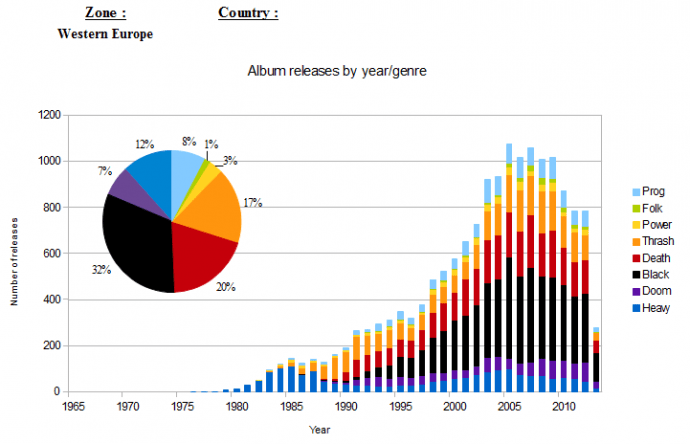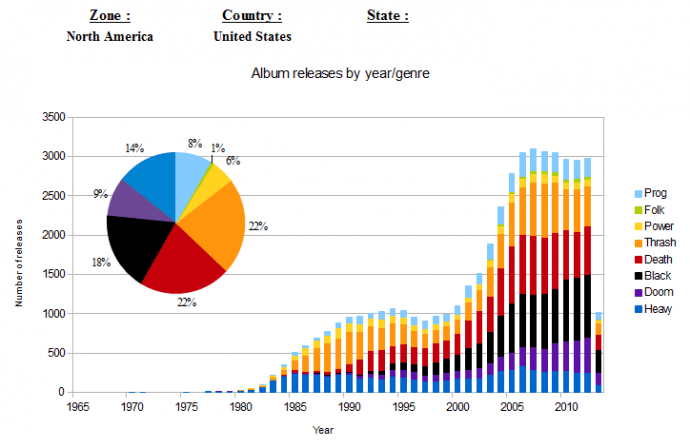EDITOR’S NOTE: A French reader of this site whose moniker is Eldhoraz has devoted an impressive amount of effort gathering and analyzing data from Encyclopaedia Metallum about the release of metal albums over an extended period of time. He has organized the information both within geographic regions and according to eight metal genres and has created a variety of interactive charts displaying the results. At the end of this article, you’ll have the chance to download a spreadsheet file containing his analysis, along with a document describing his methodology in further detail. Very interesting stuff, and we’re very happy to share it with you.
Well. Although I spend all my spare time listening to and fun-facting about metal, I’m basically a graduate student in a scientific field. And when these two aspects of my personality spend a night together, there comes, sometime later, this cute and cheeky baby.
Here and there, I often read sentences such as, “Finland is definitely the most metal country on Earth,” or “I knew Southeastern Asia was mostly death metal,” and it inspired me to quantify “metalness” in time and in space, in order to distinguish the factual from the fictional.
So I spent some days – and some nights – on the amazing database of Encyclopaedia Metallum, collecting data to satisfy my curiosity. And here are some of the interesting things that came out of that analysis.
First, I’d like to denounce an urban legend: Finland is NOT the most metal country on Earth. It’s Luxembourg! Well, if we don’t consider countries with fewer than 500,000 people, Finland wins up the irons, with 1780 bands per million people. Finland is followed by Sweden (1129), Norway (781), Denmark (363), and… Estonia (342) ! Needless to say, it seems that Northern Europe has the touch. In comparison, the United States ranks 25th with only 150 bands per million people, the UK ranks 24th, France is 27th, Germany 9th, etc. But Finland is even more impressive. It is not only first in the general ranking, it’s also the most metal country in every granular metal sub-genre defined for purposes of this analysis!
But these insights are not the only ones that the data give us. We also obtain interesting charts like this one:
It shows us the evolution of album releases across the whole world. We see that metal is highly dependent on the dynamism of the music industry and the medium in which it propagates. The invention and popularity of CDs in the late 70’s and early 80’s triggered an impressive acceleration of record releases across the world, thanks to the increased ease of producing and obtaining albums. It also demonstrably led to the accelerated growth of metal scenes in countries distant from the West.
Similarly, the invention of the Internet boosted the growth of metal in the late 90’s and early 00’s, and in even more recent years the availability of metal has again boomed due to the increase in digitally self-released albums, and the increased ability of new bands to disseminate their music via a widespread broadcast. We can also see in the data the dramatic influence of the most recent global economic crisis, which has had a dampening effect on releases despite the development of the Internet and the rapidly growing number of digital-only releases.
The data also show the varying effects of the crisis on releases by bands in different countries:
For example, we note that American bands on average seem to be more independent of the labels (whose business we would expect to have suffered from the economic downturn), and therefore production of albums didn’t decrease during the recession, while it shrank in an unprepared Europe.
Another interesting thing about the American chart is the diminution of album releases from 1994 to 1997. This may be explained by the sudden expansion of the grunge scene and the creation of a large alternative rock/metal offspring that largely wiped out metal from the mainstream, and partly from the underground, for five years.
The Metal Archives information is also revealing about local preferences among metal subgenres. For example, in the US, the scenes are mostly thrash and death oriented, while in Western Europe, black metal wins. And as Islander would say, “black metal is the most saturated subgenre”.
The reasons for these variations in local preferences remain to be discussed and explained, as do the differing musical evolutions within each of the various geographic zones and their link to local economic, societal, and political conditions. Metal is in opposition with society, but, as the subgenres embody different philosophical positions, their distribution among countries may give us information about the mood of the underground and its impact on the country in which it evolves. If Norway’s and Sweden’s metal preferencies are so different, for example, it is because Norwegian and Swedish societies must somehow be drastically different.
And by the way, yes, black metal IS the main export product of Norway.
One last important feature of the database is that it also allows us to study the dynamics of the expansion of an underground trend. For example, the following map enables us to monitor the expansion of doom metal in the last decade across the United States:
We can observe the expansion of doom/sludge, apparently originating in New Orleans and spreading around in the neighboring states. I haven’t tried it yet, but it would be interesting to visualize the expansion of death metal from Florida, or the second wave of black metal from Norway, etc.
For those who are interested, the file I worked with can be downloaded from here:
https://www.dropbox.com/s/ye3kfkm7e2da711/Metal%20World%20Map.rar
In the archive, you’ll find a “Read Me” explaining how the file works and how you can play with it. Don’t do as usual. Read it.







Interesting work. I will say however your ranking of the US (and to a degree other countries) is wrong because the data you are working from (Metal Archives)is flawed. Due to their stricter then reality genre standards which leave many bands who are metal (but not to Metal Archives standards) or have enough of a metal influence to be considered within metal, out in the cold. I would go further and say that Europe and other countries have more bands that would be considered okay for Metal Archives because of their more traditional genre love and that the US with a wider host of experimental genre confusing acts has more of the bands that Metal Archives would not allow.
Yes of course, the results you obtain always depend on the reliability of the data you’re working with, and, although the Metal Archives have a really extensive database –90,000+ bands currently– their very strict definitions of what’s metal and what is not let aside a huge number of bands — and I know that but enough, half of my band submissions on MA having been rejected.
Thus, indeed, the ranking is likely to be wrong. But the global trends and evolutions are still representative, I think. But that was fun counting the number of releases in North Dakota or in Idaho, though, because some smaller and less populated countries had more releases 🙂
Encyclopaedia Metallum (Metal Archives) is NOT flawed. They keep -core and screamo garbage out of the archives as a service to all of humanity.
He’s not totally wrong. Some tangent bands are rejected, and members don’t even try screamo or emocore 🙂
She*
Actually I would argue most of the “metal approved” metalcore bands on the Archives take more influence from screamo, for example: As I Lay Dying, Killswitch Engage, etc.
Of course the data is slightly flawed, but it would be impossible to please everyone’s standards here. The graphs are nonetheless informative and interesting!
I’d argue that “screamo” isn’t even a real thing. It’s a label applied to so many bands who fit under other labels well enough.
Totally, but then we get into the discussion of subgenres vs. “scenes”. If you want to be really stingy about it: crossover, djent, NWOBHM, groove metal all go out the window.
Hell, even the term “progressive” or the prefix “post-“… they’re so subjective that I almost don’t want to use them anymore.
Their policy is simple, though : more influenced by metal than by any other genre. They admit crossover thrash only when they judge it’s metal enough — same with djent, NWOBHM, groove. Yes, it’s a subjective line they draw, but they had to draw a line somewhere… Else what ? They would have accepted punk hardcore, then punk, then rock, then hard rock, etc. It’s unending. Yes, they seem very strict — and they probably are — but it was necessary for the sake and the serious of their database. And it can’t be pleasing everyone.
Of course the line has to be drawn somewheres. Some people just have a different view of where that line rests! It doesn’t entirely negate the information you’ve collected, but there is certainly an expected margin of “error” due to the subjectivity of the definitions. I have few issues with the Archives, and I think it is a great resource.
Oh yes, I’m not trying to hide the margin of error of my work, you know. I’m just telling that the archives are definitely the best metal resource ever, and even if some borderline bands/scenes could be added to the study, their number is really small compared to the gargantuan amount of registered bands on the archives.
You are right it is a bad label for bands that fit under other umbrellas. However it did start in the U.S as a real thing. Ever heard of Orchid, Pg. 99, Circle Takes The Square, City of Caterpillar? That is screamo. No other tag applies. Now everything that followed after…I would call more emo/metalcore than anything else. So it was not so much a concrete style but a way to describe some emerging groups taking their music in a different chaotic direction that then got mis-appropriated by the scene/labels/etc
Right, there are a specific set of sounds associated with screamo. The bands you listed seem to be the best examples, but there are borderline bands that I think also fit the description (and I enjoy very much): Bucket Full of Teeth, Portraits of Past (more universally recognized as screamo), the Sound of Animals Fighting, the March of Echoes (could also be sludge), the Number Twelve Looks Like You…
Then again you could just lump them into hardcore or metalcore. I guess it depends on how you look at it!
So many band names in this conversation that I have not seen in forever.
Agree. May we be focusing on metal, folks ?
No way, this comment space is officially hijacked! Next we’ll discuss deathcore :^] jk dude.
There also appears to be an extreme disconnect between sludge and metalcore, although the subgenres typically coincide (and in IMHO can often be interchangeable terms). There are a TON of sludge bands on the Archives. Still think they keep -core “garbage” out? Shall we discuss thrash/crossover? How about grindcore???
This guy gets it 😀
M-A founder spotted !
\m/ !!!
Now if we can get anthropology duder from earlier on to use this we may been on to something really cool.
Actually, I’m considering pushing this study a bit further. I would be ashamed of having spent so much time on this not to do something consistent about it.
Very interesting. I wonder if the popularity of doom metal stems from the more poor economic conditions in tha area.
That’s exactly this kind of links -between local genre preferences and economic, societal, and political context, that I want to study further.
Quite the extensive report you have here. My personal interest is in the fast growing Asian metal scene. I’m especially wondering why there are so many black metal bands coming out of China.
This in an interesting question, and I might have an explanation. The black metal scene isn’t the only one that’s growing fast in China. A bit like Russia and the former countries of USSR like Belarus, Ukraine, Estonia, etc, there’s a rapid expansion of a folk metal scene — at least compared to the global average. Black metal consists in a desecration of the widely accepted moral and social values, and their replacement by other values, whatever they may be. Folk metal deals with traditions and original cultures. When mixed together, it often demands a return to traditional values, sometimes in a nationalist way. China has been through three successive waves of forced modernization, and it’s the society whose values have been the more often trampled. And since the Chinese society and its living conditions are being slowly westernized, black metal appears like a proper way to be in such a reactionary position against the will of the government.
Nice work Eldhoraz! As a scientist myself, I fully approve of going uber-geek with some math analysis of metal.
This is certainly a lot more insightful than One’s counting of the year-end lists.
But, Luxembourg though… Anybody here even know bands from Luxembourg?
I do ^^ but that doesn’t count, since I’m the guy who made that study. You should check out Abstract Rapture — from Luxembourg, of course — and they’re good 🙂
Stumbled on this post earlier. Is this file still available somewhere in the cyberverse?
Well… No, and yes. It has actually become obsolete and I’m not using it any longer, which is why I took it back from Dropbox. I’m now working with a new, automated version running with Scilab, which allows me to use raw data from the archives that Hellblazer kindly provides. If you are interested in using this new version, ask Islander my e-mail address (I don’t want to type it here) via the ‘Contact us’ page up there. I’ll be happy to give you thr file and help you with it!